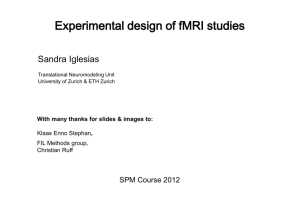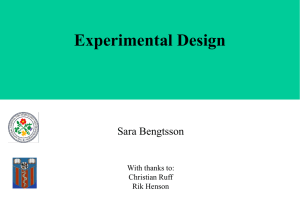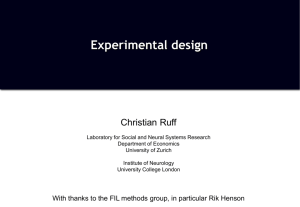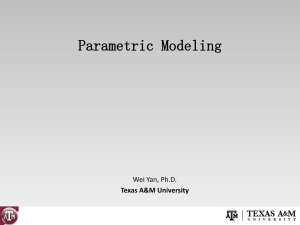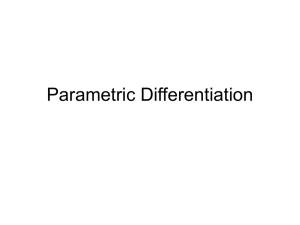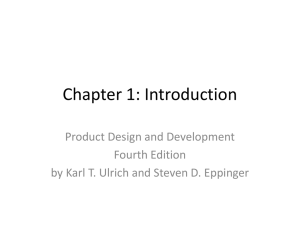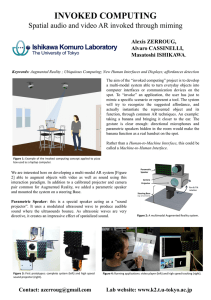Experimental design
advertisement
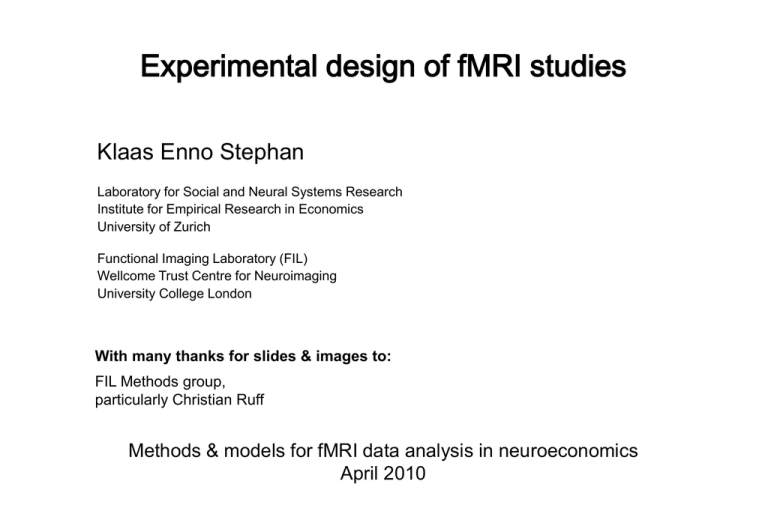
Experimental design of fMRI studies
Klaas Enno Stephan
Laboratory for Social and Neural Systems Research
Institute for Empirical Research in Economics
University of Zurich
Functional Imaging Laboratory (FIL)
Wellcome Trust Centre for Neuroimaging
University College London
With many thanks for slides & images to:
FIL Methods group,
particularly Christian Ruff
Methods & models for fMRI data analysis in neuroeconomics
April 2010
Overview of SPM
Image time-series
Realignment
Kernel
Design matrix
Smoothing
General linear model
Statistical parametric map (SPM)
Statistical
inference
Normalisation
Gaussian
field theory
p <0.05
Template
Parameter estimates
Overview
•
Categorical designs
Subtraction
Conjunction
- Pure insertion, evoked / differential responses
- Testing multiple hypotheses
• Parametric designs
Linear
Nonlinear
•
- Adaptation, cognitive dimensions
- Polynomial expansions, neurometric functions
Factorial designs
Categorical
Parametric
- Interactions and pure insertion
- Linear and nonlinear interactions
- Psychophysiological Interactions
Cognitive subtraction
•
•
Aim:
– Neuronal structures underlying a single process P?
•
Procedure:
– Contrast: [Task with P] – [control task without P ] = P
the critical assumption of „pure insertion“
Example:
-
Neuronal structures
computing face recognition?
Cognitive subtraction: Baseline problems
• „Distant“ stimuli
Several components differ!
• „Related“ stimuli
P implicit in control task ?
„Queen!“
„Aunt Jenny?“
• Same stimuli, different task
Interaction of task and stimuli (i.e. do task
differences depend on stimuli chosen)?
Name Person!
Name Gender!
A categorical analysis
Experimental design
Word generation
Word repetition
G
R
RGRGRGRGRGRG
G - R = Intrinsic word generation
…under assumption of pure insertion
Overview
•
Categorical designs
Subtraction
Conjunction
- Pure insertion, evoked / differential responses
- Testing multiple hypotheses
• Parametric designs
Linear
Nonlinear
•
- Adaptation, cognitive dimensions
- Polynomial expansions, neurometric functions
Factorial designs
Categorical
Parametric
- Interactions and pure insertion
- Linear and nonlinear interactions
- Psychophysiological Interactions
Conjunctions
• One way to minimise the baseline/pure insertion problem is to isolate the
same process by two or more separate comparisons, and inspect the
resulting simple effects for commonalities
• A test for such activation common to several independent contrasts is
called “conjunction”
• Conjunctions can be conducted across a whole variety of different
contexts:
• tasks
• stimuli
• senses (vision, audition)
• etc.
• Note: the contrasts entering a conjunction must be orthogonal !
Conjunctions
V
R
P
Object viewing (B1)
Colour viewing (A1)
Object naming (B2)
Colour naming (A2)
V,R
V
P,V,R
P,V
Price et al. 1997
Viewing
Naming
Colours
Visual Processing
Object Recognition
Phonological Retrieval
Stimuli (A/B)
Example: Which neural structures support object recognition,
independent of task (naming vs viewing)?
A1
A2
Objects
Task (1/2)
B1
B2
Common object
recognition response (R)
(Object - Colour viewing) [1 -1 0 0]
&
(Object - Colour naming) [0 0 1 -1]
[ V,R - V ] & [ P,V,R - P,V ] = R & R = R
A1
B1
A2 B2
Conjunctions
Two types of conjunctions
“Which voxels show effects of similar
direction (but not necessarily
individual significance) across contrasts?”
Null hypothesis: No contrast is significant: k = 0
does not correspond to a logical AND !
B1-B2
• Test of global null hypothesis:
Significant set of consistent effects
p(A1-A2) <
+
+
p(B1-B2) <
• Test of conjunction null hypothesis:
Set of consistently significant effects
“Which voxels show, for each specified
contrast, significant effects?”
A1-A2
Null hypothesis: Not all contrasts are significant:
k<n
Friston et al. (2005). Neuroimage, 25:661-667.
corresponds to a logical AND
Nichols et al. (2005). Neuroimage, 25:653-660.
SPM offers both types of conjunctions
specificity
sensitivity
Global null:
k=0
Conjunction null:
k<n
(or k<1)
Friston et al. 2005, Neuroimage, 25:661-667.
F-test vs. conjunction based on global null
grey area:
bivariate t-distriution
under global null hypothesis
Friston et al. 2005, Neuroimage, 25:661-667.
Using the conjunction null is easy to interpret, but can be very
conservative
Friston et al. 2005, Neuroimage, 25:661-667.
Overview
•
Categorical designs
Subtraction
Conjunction
- Pure insertion, evoked / differential responses
- Testing multiple hypotheses
• Parametric designs
Linear
Nonlinear
•
- Adaptation, cognitive dimensions
- Polynomial expansions, neurometric functions
Factorial designs
Categorical
Parametric
- Interactions and pure insertion
- Linear and nonlinear interactions
- Psychophysiological Interactions
Parametric designs
• Parametric designs approach the baseline problem by:
– Varying the stimulus-parameter of interest on a continuum, in multiple (n>2)
steps...
– ... and relating measured BOLD signal to this parameter
• Possible tests for such relations are manifold:
• Linear
• Nonlinear: Quadratic/cubic/etc. (polynomial expansion)
• Model-based (e.g. predictions from learning models)
F-contrast [0 1 0] on
quadratic parameter
→ inverted ‘U’ response to
increasing word presentation
rate in the DLPFC
SPM{F}
Linear
Parametric modulation of regressors
Polynomial expansion:
f(x) ~ b1 x + b2 x2 + b3 x3 ...
SPM offers polynomial expansion as
option for parametric modulation of
regressors
Büchel et al. 1996, NeuroImage 4:60-66
Parametric modulation of regressors by time
Büchel et al. 1998, NeuroImage 8:140-148
“User-specified” parametric modulation of
regressors
Polynomial expansion
&
orthogonalisation
Büchel et al. 1998, NeuroImage 8:140-148
Investigating neurometric functions
(= relation between a stimulus property and the neuronal response)
Pain threshold: 410 mJ
P1
P2
P3
P4
Stimulus
awareness
Stimulus
intensity
Pain
intensity
P0-P4: Variation of intensity of a laser stimulus
applied to the right hand (0, 300, 400, 500, and 600
mJ)
Büchel et al. 2002, J. Neurosci. 22:970-976
Neurometric functions
Stimulus intensity
Stimulus presence
Pain intensity
Büchel et al. 2002, J. Neurosci. 22:970-976
Model-based regressors
• general idea:
generate predictions from a computational model, e.g. of
learning or decision-making
• Commonly used models:
– Rescorla-Wagner learning model
– temporal difference (TD) learning model
– Bayesian learners
• use these predictions to define regressors
• include these regressors in a GLM and test for significant
correlations with voxel-wise BOLD responses
Model-based fMRI analysis
Gläscher & O‘Doherty 2010, WIREs Cogn. Sci.
Model-based
fMRI analysis
Gläscher & O‘Doherty 2010, WIREs Cogn. Sci.
TD model of reinforcement learning
V (t 1)
V (t ) R(t ) V (t 1) V (t )
•
•
appetitive conditing with pleasant taste reward
activity in ventral striatum and OFC correlated with TD prediction error at
the time of the CS
O‘Doherty et al. 2003, Neuron
Learning of dynamic audio-visual associations
1
Conditioning Stimulus
CS1
Target Stimulus
CS2
0.8
or
p(face)
or
CS
0
Response
TS
200
400
600
Time (ms)
800
0.6
0.4
0.2
2000
±
650
0
0
200
400
600
trial
den Ouden et al. 2010, J. Neurosci .
800
1000
Bayesian learning model
pk 1
k
volatility
vt-1
pvt1 | vt , k ~ N vt , exp(k )
vt
probabilistic association
rt
rt+1
observed events
ut
ut+1
prt 1 | rt , vt ~ Dirrt , exp(vt )
prediction: p rt , vt , K u1:t 1 p rt rt 1 , vt 1 p vt vt 1 , K p rt 1 , vt 1 , K u1:t 1 drt 1dvt 1
update: p rt , vt , K u1:t
p r , v , K u p u r dr dv dK
t
Behrens et al. 2007, Nat. Neurosci.
p rt , vt , K u1:t 1 p ut rt
t
1:t 1
t
t
t
t
Probability
Volatility
10
10
posterior pdf
posterior pdf
5
15
20
25
30
35
40
45
20
30
40
50
60
70
50
100
200
300
400
500
80
100
200
300
400
500
1
p(F|CS)
0.8
0.6
0.4
CS1
volatility
target
0.2
0
400
CS1
CS2
440
480
520
trial
560
600
400
440
480
520
trial
560
600
Stimulus-independent prediction error
Putamen
Premotor cortex
p < 0.05
(cluster-level wholebrain corrected)
0
-0.5
0
-0.5
-1
-1.5
-2
BOLD resp. (a.u.)
BOLD resp. (a.u.)
p < 0.05
(SVC)
-1
-1.5
p(F)
p(H)
den Ouden et al. 2010, J. Neurosci .
-2
p(F)
p(H)
Overview
•
Categorical designs
Subtraction
Conjunction
- Pure insertion, evoked / differential responses
- Testing multiple hypotheses
• Parametric designs
Linear
Nonlinear
•
- Adaptation, cognitive dimensions
- Polynomial expansions, neurometric functions
Factorial designs
Categorical
Parametric
- Interactions and pure insertion
- Linear and nonlinear interactions
- Psychophysiological Interactions
Main effects and interactions
Colours
Objects
Stimuli (A/B)
Task (1/2)
Viewing
Naming
A1
A2
B1
B2
• Main effect of task:
(A1 + B1) – (A2 + B2)
• Main effect of stimuli: (A1 + A2) – (B1 + B2)
• Interaction of task and stimuli:
Can show a failure of pure insertion
(A1 – B1) – (A2 – B2)
interaction effect
(Stimuli x Task)
Colours Objects
Viewing
Colours
Objects
Naming
Example: evidence for inequality-aversion
Tricomi et al. 2010, Nature
Psycho-physiological interactions (PPI)
Stim 1
Stim 2
Stimulus factor
Task factor
Task A
Task B
TA/S1
TB/S1
TA/S2
TB/S2
We can replace one main effect in
the GLM by the time series of an
area that shows this main effect.
E.g. let's replace the main effect of
stimulus type by the time series of
area V1:
GLM of a 2x2 factorial design:
y (TA TB ) 1
main effect
of task
( S1 S 2 ) β 2
main effect
of stim. type
(TA TB ) ( S1 S 2 ) β 3
interaction
e
y (TA TB ) 1
V 1β 2
(TA TB ) V 1β 3
e
main effect
of task
V1 time series
main effect
of stim. type
psychophysiological
interaction
PPI example: attentional modulation of V1→V5
SPM{Z}
V1
V5 activity
Attention
V5
time
V1 x Att.
V5
Friston et al. 1997, NeuroImage 6:218-229
Büchel & Friston 1997, Cereb. Cortex 7:768-778
V5 activity
=
attention
no attention
V1 activity
PPI: interpretation
y (TA TB ) 1
V 1β 2
(TA TB ) V 1β 3
Two possible
interpretations
of the PPI
term:
e
attention
V1
V5
Modulation of V1V5 by
attention
attention
V1
V5
Modulation of the impact of attention on
V5 by V1.
Thank you
